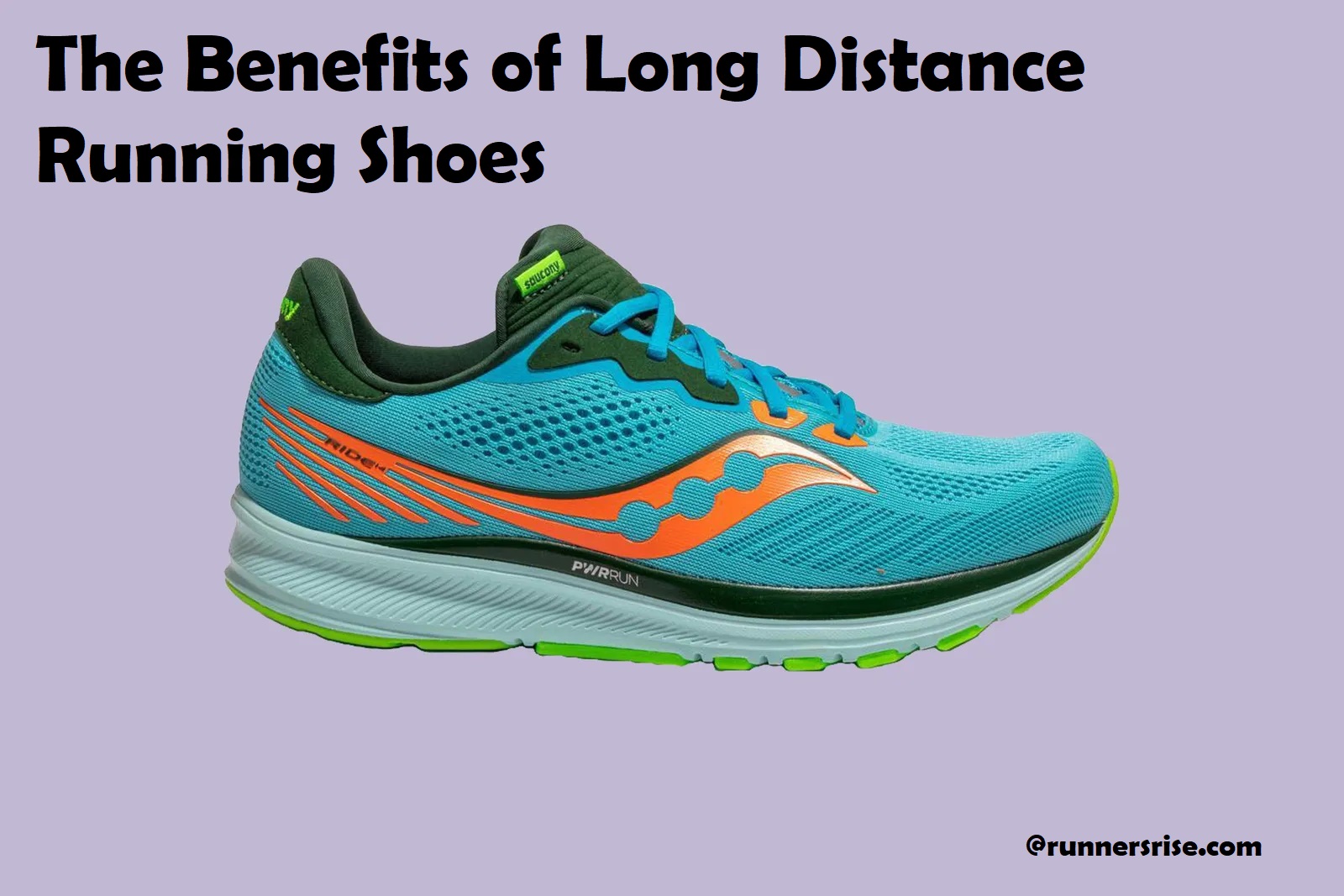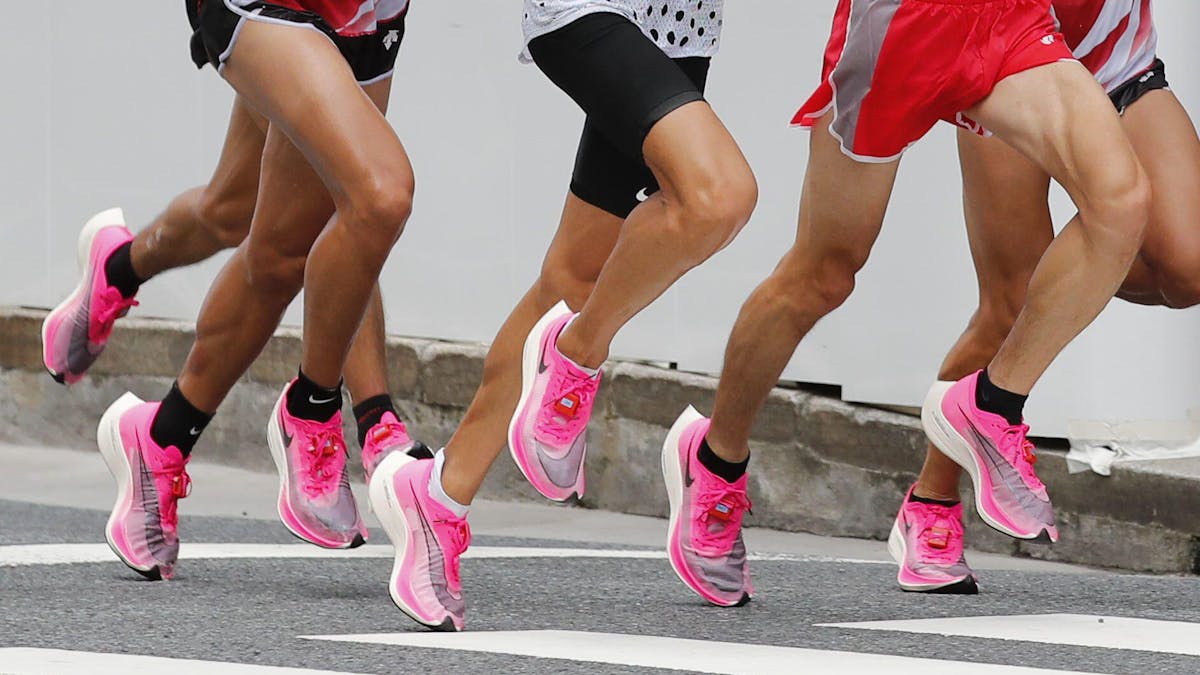Are you an avid runner looking for the perfect shoe to help push your limits? Long distance running shoes offer the specialized support and cushioning you need to reach great distances.
Read on for a complete guide to the benefits of long distance running shoes.
Running is one of the most popular forms of exercise in the world, and it’s no wonder why: it’s easy to do, affordable, and has a wide range of benefits. In order to maximize your running benefits, it is important to choose the right type of shoes. Long distance running shoes are specifically designed for longer runs such as marathons or half-marathons and are an excellent option for athletes who run regularly. In this guide you will learn about the advantages of long distance running shoes and tips on how to choose the right pair.
Long distance running shoes are specially designed with extra cushioning and support than regular running shoes so that your feet feel more comfortable during longer runs. The cushioning prevents too much impact on your feet as you run which can result in increased joint pain or injuries over time. Specialized cushioning materials such as ethylene vinyl acetate (EVA) can help absorb shock when your feet hit the ground so that impact is minimized, resulting in less overall discomfort during a long run. Extra support features such as midsole foam allows for additional stability when making turns or going up hills, reducing the likelihood of injury due to instability in certain conditions.
These specialized features also provide increased energy return which can help you power through those last few miles before crossing the finish line – something that all long-distance runners know can be grueling at times! Additionally some manufacturers add in better durability features so you know that your long-term investment won’t need replacing anytime soon.
Comfort and Fit
Long-distance and marathon running shoes differ from sprinting shoes in several ways. The main ones being they are designed to provide you with extra cushioning and support during the course of a long run or race. As such, comfort and fit are major factors to consider when shopping for a running shoe. Some of the key elements to look for include:
— Cushioning: Marathon runners will benefit from cushioning technology that is designed to absorb shock, help protect your feet from stress and help reduce fatigue during those longer runs. Look for the words “Air” or “Gel” when shopping for cushioned running shoes.
— Forefoot Support: If a shoe offers too much flexibility in its forefoot design, it can cause feet pronation (how your foot rolls inwards). This can lead to pain, discomfort and even potential injury over time. Look for shoes that advertise as offering extra supportive features such as arch supports or reinforced heel support structures.
— Fit: Make sure that you get fitted properly by an experienced sports store assistant who will measure your feet correctly and recommend the right size based on your individual foot shape and arch type. It’s also important to ensure that you have enough space between your toe box and the shoe materials – be sure there’s not too much or too little room against your toes in order to feel secure within the shoe with each stride you make during your runs or races.
Importance of comfortable shoes for long distance running
Comfortable shoes are essential for long-distance running, as the wrong type of footwear could cause injuries or at the very least discomfort while you are out running. A quality pair of long-distance running shoes should be lightweight, durable, and provide plenty of cushion to absorb any shock or impact on your joints. It’s important to choose the right type of shoe for the kind of terrain you plan to traverse — you don’t want to be stuck with a pair that is ill-suited for a particular kind of terrain.
Here are some features you may want to look out for when selecting your ideal pair:
- Breathability – Look for shoes that have mesh panels or open weave uppers as these provide more airflow and will help keep your feet cooler when running in hot conditions.
- Lightweight – Lightweight shoes allow you to travel further with less effort, as heavier shoes can tire you out faster because of their bulk.
- Good Fit – Just like in other footwear, ill-fitting shoes can cause problems such as chafing or blisters. Always make sure your shoe fits well; this includes length, width and heel drop (the difference between the height of your heel compared to your toe).
- Cushioning – Choose a shoe with ample cushioning and arch support which will reduce the impact from each step taken so that there is less stress placed on the bones and muscles in your foot and leg.
Factors to consider when selecting long distance running shoes
When shopping for a pair of long distance running shoes, there are several factors that should be taken into consideration. The type of cushioning and support, the construction of the midsole, and the design of the upper should all be evaluated in order to determine what will best suit you and your unique needs. Let’s take a look at each factor:
Cushioning and Support: Most manufacturers offer running shoes with various levels of cushioning and support to meet individual needs. Cushioning helps reduce stress on joints when running, while support helps provide stability and shock absorption. Depending on your personal preference and type of terrain you are typically running on, you may prefer a softer or firmer cushioning material or degree of support. It is best to try on different pairs to see what offers the most comfortable ride for your feet.
Midsoles: Midsoles are usually made from a dense foam material called Ethylene-Vinyl Acetate (EVA). This foam offers lightweight cushioning that helps stabilize feet during longer runs by absorbing shock and providing extra durability in areas subjected to intense impact. Different densities also affect how soft or firm the cushioning is, so again it is best to test out different types before purchasing.
Uppers: Uppers come in several different materials such as leather, synthetic suede or mesh that can breath easily–an important feature for preventive moisture control during extended runs in hot weather conditions. Depending on your environment, some materials may prove more suitable than others as they all provide varying degrees of comfort/durability/flexibility etc… So make sure you research which option might work best for you!
Fitting techniques
Since running shoes come in a variety of styles, it is important to make sure that you select the right fit for your foot type. To properly fit long distance running shoes, there are a few techniques you should follow.
First, ensure that there is ample room in the toe box. Your toes should have the space to wiggle and move freely without feeling constricted. Make sure to try on both shoes before deciding on a pair to ensure that one foot isn’t larger than the other.
Second, check the pass of your heel through the upper of the shoe before tightening up your laces or buckles. You want as snug a fit as possible without causing any discomfort or squeezing your feet too tightly into place – this could lead to blisters or pain while running.
Third, evaluate whether or not arch support comes with the shoe you are fitting on – if not, insert an over-the-counter sole into each shoe to provide additional arch support while running distances.
Finally, take several strides and jump around if possible when trying on new shoes; this will give you an idea as to how they feel once you begin exercise and help determine whether or not they are suitable for long distance runs.
Cushioning and Stability
Cushioning refers to the level of shock absorption a running shoe has. As the foot touches the ground and absorbs impact, cushioning helps to disperse that impact and protect feet from injuries. Generally, cushioning levels are divided into three categories – soft, medium and firm.
The level of cushioning a runner should use depends on their fitness goals as well as their weight and running experience. Heavier runners may need more cushioning because they generate greater force when contacting the ground than lighter runners. Experienced runners may also prefer more cushion or less, depending on the terrain they run on most often or what type of racing they do most frequently (e.g., trail).
Stability refers to how much weight is shifted off of each individual foot while in motion; it prevents injuries by controlling any excessive pronation or supination that occurs while running. Most stability running shoes have features such as roll bars, medial posts and flex grooves to support your feet’s natural movement while providing stability for optimal performance throughout training sessions.
Importance of cushioning in long distance running shoes
Cushioning plays an essential role in long distance running shoes, and it is very important for runners to understand the characteristics of various cushioning solutions. Cushioning consists of a material that compresses and rebounds quickly in order to absorb impact shock generated during activities such as running. Not only do cushioning materials improve comfort and reduce fatigue, they also act as a shock absorber, shielding the runner’s joints from hard surfaces like pavement or gravel. The cushion should also be responsive so it returns to its original shape quickly after a runner’s foot strikes the ground. Generally speaking, most long distance running shoes will include some type of cushioning material or technology designed specifically for this purpose.
Common types of cushioning materials used in long distance running shoes include:
-EVA (Ethylene-Vinyl Acetate) – This is one of the most common types of foam found in running shoes, providing lightweight cushioning and exceptional durability.
-Gel – Gel is another popular type of foam found in many long distance running shoes. It is comprised mostly of silicone with suspended particles that provide added responsiveness at heel strike.
-Air – This is perhaps the most popular form of cushioning used in long distance running shoes today. Air-filled units are typically encapsulated within cushions made out of either foam or other materials forms such as ethylene vinyl acetate (EVA). The air chambers act as tiny springboards underfoot, ensuring that runners receive maximum return for each step taken during their run, improving reaction time and overall performance.
Types of cushioning
In terms of cushioning, there are several types. It is important to consider the type of cushioning provided by your shoes as it will affect your comfort and performance levels. The types of cushioning available vary, though the primary categories are neutral cushions and stability/motion-control cushions:
Neutral Cushioning – A minimal amount of cushioning is applied in order to allow the foot to move naturally while still maintaining adequate protection over different terrains.
Stability/Motion Control Cushioning – This type of cushion provides extra support around areas that need it most such as pronation control or arch support by providing additional cushion and reducing the shock generated by impact. This is best suited for runners who have feet that are prone to movement issues such as overpronation or supination.
Also available are responsive cushion types that offer more energy return than conventional models, which can be beneficial for runners who require a bit more spring in their step when running long distances.
Importance of stability in long distance running shoes
For any long distance running enthusiast, finding the perfect pair of shoes can be important for success. Stability is an essential component of any running shoe but plays an even more important role in longer distance runs. Stable shoes are able to provide greater support and cushioning to keep you comfortable throughout your run, and they have enhanced traction capabilities to help prevent falls when running on uneven terrain. Finding the right combination of stability and comfort is key in order to maximize performance and reduce injury risk that can occur as a result of improper footwear.
When looking for a stable long-distance running shoe, look for cushioning around the entire length of the foot and toe area. Having cushioning along with stability will protect your feet from impact while providing protection from overpronation which can lead to fatigue or injury. Additionally, look for features added specifically geared towards long-distance such as energizing technologies or ROLLBAR technology which are specifically designed for athletes with higher arches or arch pronation needs. It’s also beneficial to look for shoes with protective rubber outsoles offering increased durability and extra grip on outdoor surfaces where there could be slippery conditions such as light rain or snow.
Durability and Traction
Durability and traction are two important factors to consider when purchasing running shoes. Shoes designed for long distance running need to not only be comfortable, but also be able to withstand miles of wear and tear. A good quality pair of shoes can last thousands of miles without showing excessive signs of wear. Additionally, durability is especially important if you plan on taking your shoes on treacherous terrain. If a shoe lacks adequate grip, it could lead to a dangerous situation on slick surfaces or shortcuts through overgrown trails.
Traction is determined by several factors; the outsole pattern, rubber compounds used in construction, and the depth of the tread all play a role in grip. Many manufacturers have now started incorporating rubber that is specifically designed for road running or trail running into their designs, which will provide extra bite into different surfaces depending on the type used. Look for features such as carbon rubber outsoles with aggressive tread patterns for extra traction when searching for your perfect fit.
Importance of durability in long distance running shoes
When it comes to long distance running, having the right footwear is critical for success. Durability is of utmost importance when it comes to finding the perfect pair of running shoes; after all, it is these shoes that will protect and support you as you tackle a tough 10k or half-marathon.
When thinking about the durability of your shoes, certain factors should be taken into account. The outsole should be made of a durable material that can withstand miles of continuous mileage without suffering any damage. The midsole should also provide good cushioning and support, as well as good shock absorption during impactful exercises. If possible, the lacing system should be reliable and adjustable ensuring comfort and proper fit throughout your run. Additionally, certain fabrics may need to be used in the upper so that there is enough protection against wear and tear from continuous miles in all weather conditions.
Ultimately, by investing in well-made long distance running shoes with impressive durability features, you are providing your feet with better protection for your runs; enabling yourself to train longer, harder and faster than ever before!
Factors affecting the durability of long distance running shoes
Durability is one of the most important factors to consider when buying long distance running shoes. The life of the shoe will depend on countless factors, such as construction material, type of foam used and whether or not the upper is reinforced with extra padding. Running in inclement weather, such as rain or snow, will also affect the durability. While you can’t predict every factor that may affect the lifespan of a running shoe, there are several tips to remember that can help you choose a shoe that will last longer.
– Look for shoes made with leather or synthetic materials that are both more durable than mesh and breathable at the same time.
-Choose a running shoe with an extended gum rubber heel which provides cushioning, support and better traction on wet surfaces
-Opt for midsoles made with special foams designed for better shock absorption over softer foams (EVO) or firmer foams (Energy).
-Look for reinforced uppers on racing flats which provide protection from road debris
-Try to avoid styles covered with thin mesh fabric because they are not very durable and can tear easily.
-Buy a size slightly bigger than you would normally wear so your foot has room to move while avoiding too much movement within.
Importance of traction in long distance running shoes
Traction is an important factor when choosing running shoes, especially those designed for long distances. Traction relates to the soles of the shoes and how much grip and control they give onto the ground beneath during your run. Good traction ensures that your feet stay connected with the terrain, giving you stability and better balance as you run.
Long distance running shoes should provide enough grip to handle wet and slippery surfaces, as well as uneven trails or pathways that you might encounter. Shoes with good traction will also protect against blisters, which are more likely on softer grounds where your feet may slip back and forth in the shoe due to a lack of grip.
When purchasing running shoes for long distances it is important to consider whether their sole design provides enough traction for varied surfaces and climates. Shoes with deep lugged soles are typically better suited for trails with plenty of rocks, sticks, roots and other natural obstacles that need to be avoided or jumped over. Furthermore, certain materials may offer better traction than others such as rubber which is known to have good grip on dry surfaces while some specialized foams can hold out against moist environments even better. Be sure to also check if your shoes have any tread patterns as these can help provide further resistance when traversing down steep slopes or uphill routes during longer runs.
Conclusion
In conclusion, choosing the right running shoes can be a challenge. The best way to make sure you get the right shoe is to know your foot type and choose a shoe that fits snugly but comfortably. Specialty running stores can be helpful in providing advice and personal fitting services, or online sellers such as Runner’s World can provide plenty of assistance when it comes to selecting the perfect fit for long distance running shoes.
Investing in a quality set of long distance running shoes may cost more than buying regular sports shoes, but it can also help limit injuries, prolong the life of the shoe and give you more value for your investment.
FAQ’s
What are benefits of long distance running?
Long distance running has several benefits, such as improving cardiovascular health, boosting endurance and stamina, reducing stress and anxiety, and promoting weight loss.
What shoe is best for running long distance?
The best shoe for running long distance is one that fits well, offers adequate support and cushioning, and is designed specifically for distance running. It’s important to choose a shoe that suits your foot type, gait, and running style.
What makes a long distance running shoe?
A long distance running shoe is designed to provide cushioning and support for the feet and legs during extended periods of running. It usually has a thicker midsole, a durable outsole, and a breathable upper that allows for ventilation.
Do you need different shoes for long distance running?
It’s recommended to have a specific pair of shoes for long distance running, as these shoes are designed to provide the support and cushioning needed for extended periods of running. Using the same shoes for different types of running may cause them to wear out faster.
Is it OK to walk long distances with running shoes?
While running shoes are designed for running, they can also be used for walking long distances. However, it’s important to note that walking shoes may provide more comfort and support for the feet during long walks.
Can you walk long distances in running shoes?
Yes, you can walk long distances in running shoes. However, walking shoes may be a better choice as they are specifically designed for walking and provide more comfort and support for the feet.
Can I use running shoes for gym?
Running shoes can be used for gym workouts, but they may not provide the necessary support and stability for activities such as weightlifting and high-intensity interval training. Cross-training shoes or weightlifting shoes may be a better option for these activities.
Is it OK to wear running shoes casually?
Running shoes can be worn casually, but they may not be as stylish or comfortable as other types of casual shoes. It’s important to choose a shoe that fits the occasion and provides the necessary support and comfort for your feet.
How long do long distance running shoes last?
Long distance running shoes can last anywhere from 300 to 500 miles, depending on the type of shoe, running surface, and running style. It’s important to replace shoes when they begin to lose support and cushioning.
Can shoes last for 1,000 miles?
Shoes can technically last for 1,000 miles, but they may lose support and cushioning well before then. It’s recommended to replace shoes every 300 to 500 miles, or when they begin to show signs of wear and tear.
See Also-
- Best running shoes for beginners
- Best running shoes for bunions
- Best running shoes for heavy men
- Best running shoes for kids
- Best running shoes for knee pain


